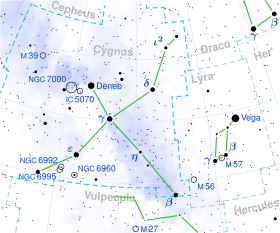天鹅座χ
| 观测资料 历元 J2000 | |
|---|---|
| 星座 | 天鹅座 |
| 星官 | |
| 赤经 | 19h 50m 33.92439s[1] |
| 赤纬 | +32° 54′ 50.6097″[1] |
| 视星等(V) | 3.3 – 14.2[2] |
| 特性 | |
| 光谱分类 | S6+/1e = MS6+[3] (S6,2e – S10,4e[4]) |
| U−B 色指数 | −0.30 – +0.98[5] |
| B−V 色指数 | +1.56 – +2.05[5] |
| 变星类型 | Mira[2] |
| 天体测定 | |
| 径向速度 (Rv) | +1.60[6] km/s |
| 自行 (μ) | 赤经:-20.16[1] mas/yr 赤纬:-38.34[1] mas/yr |
| 视差 (π) | 5.53 ± 1.10[1] mas |
| 距离 | 553 ly (169[7] pc) |
| 绝对星等 (MV) | −3.2 – +7.7[8] |
| 详细资料 | |
| 质量 | 2.1+1.5 −0.7[7] M☉ |
| 半径 | 348 – 480,[7] 737[9] R☉ |
| 表面重力 (log g) | 0.49[10] |
| 亮度 | 6,000 – 9,000[7] L☉ |
| 温度 | 2,441 – 2,742[7] K |
| 金属量 [Fe/H] | -1.00[10] dex |
| 其他命名 | |
| 参考数据库 | |
| SIMBAD | 资料 |
天鹅座χ 是在天鹅座的一颗米拉型变星,也是一颗S-型星,距离太阳系系大约600光年。.
天鹅座χ是一颗渐近巨星分支星,是一颗演化接近生命尽头,表面温度很低和明亮的红巨星。它在1686年被发现是一颗变星,其视星等从裸眼可见的3.3等至微弱到需要口径30公分的望远镜才能看见的14.2等。
历史

佛兰斯蒂德记录的天鹅座 17,就是拜耳命名的天鹅座χ。但是,当时可能看不见这颗星,但也没有进一步的资讯,直到1816年才注意到其差异[11]。拜耳记录天鹅座χ为4等星,几乎就是它的最大亮度[12]。
天文学家戈特弗里德·基什在1686年发现天鹅座χ的变异性。当时它是在研究狐狸座CK所在的天空区域并进行观测,他注意到拜耳标示的天鹅座χ在他自己编辑的测天图中并未标示出来。他继续监视这个区域,在1686年10月19日记录这颗星是5等星[13]。
基什认为天鹅座χ是一颗周期404.5天的规则变星,但很快就注意到周期和遍光幅度都会变化。汤玛斯·迪克写到[14]:
"马拉迪(Maraldi)和卡西尼解析这颗星的变光周期是405天;但是从皮戈特(Mr. Pigot)观测的平均值来看,似乎只有392天,至多也只有396-7/8天。"与它相关的具体资料是:
"它位于天鹅座的颈部,与"β"和"γ"的距离几乎相等,从"α"(天津四)向南,距离大约12度,并标示为"χ"
- 当它全亮时,在两周内没有明显的变化。
- 从11等至全亮度,大约是3.5个月,在变暗时也是如此;因此在6个月内,它可以被视为是看不见的。
- 它也不是每次都能达到相同程度的亮度,有时是5等星,有时是7等星。
直到19世纪,这颗恒星只是偶尔被观测。阿格兰德和施密特在1845年至1884年进行了持续的观测。这是第一批显示出光度变化极小值的观测结果。自20世纪初以来,一直有好几位观测者密切的观测它[15]。
最早天鹅座χ只有接近最大光度时的光谱。它们显示微弱的吸收线叠加在明亮的发射谱线上[16],在最大亮度时的光谱通常归类为M6e附近[17]。在引入S类后,天鹅座χ被视为M类和S类之间的中间环节,例如S5e或M6-M8e[18]。后来,更灵敏的光谱给出接近最小值的光谱类型晚到M10 [19]或S10,1e[20]。根据旨在更好的反映M星和碳星之间的分级修正过的S-型星分类系统,在正常最大值的天鹅座χ归类为S6Zr2Ti6或S6+/1e,被认为相当于MS6+。尽管在最低亮度下未曾进行测量,在不同阶段的光谱类型范围从S6/1e到S9/1e[3]。
在1975年,检测到天鹅座χ的SiO迈射[21]。2010年检测到天鹅座χ的大气层中有水(H2O)的发射线,但尚未找到水迈射[22]。
变异性

天鹅座χ显示出是所有脉动变星中视星等变化最大的之一[23]。观测到的极端值分别是3.3等和14.2等,亮度变化超过10,000倍[2]。平均最大亮度约为4.8等,平均最小亮度约为13.4等。光度曲线在周期和周期之间相当一致,上升比下降陡峭。大约从最小值到最大值的一半有一个"起伏",这时亮度的增加会暂时减缓,然后很快的上升到最大值[24]。在周期超过300天的米拉型变星的光度曲线中,颠簸之后的快速上升是常见的特征[25]。上升的时间大约是下降时间的41-45%[24]。
最大和最小的幅度因周期而异:最大可能会亮过4.0等或比6.0等暗淡;最小可以比14.0等更暗或亮过11.0等。2015年的最大亮度可能是近10年来最暗的,几乎只达到6.5等[26],而不到10年前的2006年 ,最大值是一个多世纪来最亮的3.8等[27]。一些所谓的最亮极小值可能只是观测未能涵盖到完整的周期[13]。英国天文学会和美国变星观测者协会的长期观测资了显示,在整个20世纪的最小值持续出现在13到14等之间[24]。
从最大值到最大值或最小值到最小值的周期并不一致,并且在平均值的任何一侧都最多有40天的差异。平均周期取决于所使用的观测周期,但通常为408.7天。有证据表明,在过去三个世纪,平均周期增加了约4天。在短时间内的周期变化似乎是随机的,而不是周期性的,然而长期的周期增加可能不是线性的。周期的变化仅在以最大值计算时较为显著,而仅使用最小值计算时则不明显[13]。
当亮度变化期间,也观测到光谱的类型有所不同(从S6到S10),在最大亮度时显示最早期的光谱。最大值之后,发射线的强度开始增加。接近最小值时,发射线变得非常强大,并且出现许多不寻常的禁线和分子线[28]。
天鹅座χ的直径可以使用干涉测量术测量。观测显示,它的直径从19毫角秒到26毫角秒不等。大小的变化几乎与亮度和光谱有着相同的相位。在最小时观察到的相位为0.94,比最大值早30天[7]。
距离
在依巴谷卫星最新的测量,天鹅座χ的周年视差是5.53毫角秒,这相当于590光年的距离。视差只有恒星角直径的四分之一,统计误差的幅度约为20% [1]。盖亚资料释放2的视差是0.2663±0.4919 毫角秒[29]。
还可以通过将角直径的变化与大气中测得的径向速度进行比较来推导出距离。这给出一个5.9毫角秒的视差,其精度与直接测量相似,相当于550光年的距离[7]。
早期的研究得出的距离通常较近,像是345光年[30],370光年[31],或430光年[32]。根据依巴谷卫星测量计算的原始视差为9.43毫角秒,得到的距离是346光年[33]。
以天鹅座χ的视星等和从周-光关系计算得到的绝对星等比较,得出的距离与最新的视差值相容[7]。
性质

天鹅座χ的体积比太阳大许多,表面温度也低很多,但尽管温度较低,它的亮度还是比太阳大数千倍。它的脉动、与半径和温度以大约409的反复变化。温度的范围在2,400K至2,700K,半径大约从350 R☉到480 R☉。这些脉动导致恒星的亮度从大约6,000 L☉到 9,000 L☉不等的变化,并且造成视星等的亮度变化超过10等[7]。巨大的视星等量级范围是电磁辐射随着温度升高而从红外偏移,以及在低温下形成的分子吸收可见光所造成的[34]。
恒星的视星等与光谱类型和温度的变化密切相关,但半径几乎与温度无关。最小半径大约发生在最高温度之前30天,总光度的变化主要是由恒星大小的变化所推动,最大光度在达到最大半径和最低温度之前大约57天发生。光度的变化落后视亮度约四分之一周期,这意味着在恒星最大亮度时光度比最小亮度时微弱[7]。
单独恒星的质量很难准确的测定。但在天鹅座χ的情况下,它的脉动提供了一种直接测量大气中层的引力加速度的方法。以这种方法测量的质量是2.1 M☉。应用米拉型变星的周期/质量/半径经验关系,给出天鹅座χ的质量是3.1 M☉ref name=lacour/>。经由时速8.5公里的恒星风,天鹅座χ的质量损失率约为每年a millionth M☉[35]。
因为光谱中含有氧化硅和氧化钛的带状谱带,天鹅座χ通常归类为S-型星。与其它的S-型星比较,ZrO的波段是微弱的,而可以看到来自VO的频带,因此有时被描述为MS,是正常的S型和M型之间的中间型。它也显示了来自S-过程元素,像是锝的光谱线。这是米拉型变星在渐近巨星分支中自然产生的[36][37]。S星是M型恒星之间的中间产物。其大气中的氧比碳多,而碳星在大气中的碳含量更多。碳通过第三次上翻的发生,被移动到大气中。S星的C/O比率介于0.95和1.05之间[38]。天鹅座χ大气中的C/O比率为0.95,与其作为S/MS星边界的状态一致[30]。
天鹅座χ是第一颗被检测到磁场的米拉型变星。据信,通常在渐近巨星分支恒星中发现的非常微弱磁场,是在恒星大气层的脉动中被冲击波放大所致[39]。
演化

天鹅座χ是在渐近巨星分支上明亮的红巨星变星。这意味着它已经耗尽了核心的氦,但质量不足以开始燃烧更重的元素,目前正在同心的壳层中燃烧氢和氦[40]。具体来说,它是在渐近巨星分支后期的热脉冲渐近巨星分支(TP-AGB)阶段,也就是处在氦壳层靠近氢壳层,并经历周期性的壳层氦闪,会有一段时间停止氦融合,并经由氢燃烧的外壳累积新的氦壳层[41]。
因为它们会失去质量,使得内部的壳层离表面越来越近,所以渐近巨星分支星会变得更亮、更大和更低温。质量的损失增加导致质量减少、光度增加,并且更多的核聚变产物被上翻至表面。质量的损失变得非常极端的"提升"渐近巨星分支,以至于它们的温度开始升高,进入后渐近巨星分支阶段,最终成为白矮星[40]。
假设它的脉动停留在不稳定的区域,米拉型变星的演化会造成它的周期增加。然而,这种长期趋势会被热脉冲打断。这些热脉冲相隔数万年,但会导致在脉冲后不到一千年的时间里产生快速的周期变化。检测到的天鹅座χ 的周期变化,暗示了热脉冲导致的快速变化结束。脉冲之间的周期变化太慢,尚无法用当前的检测值检测出来[42][43]。
在热脉冲渐近巨星分支上的热脉冲,在渐近巨星分支阶段结束前会逐渐产生更剧烈的变化[43]。每个脉冲都会导致内部不稳定,从而触发表面向氢壳层的对流。当对流区域变得足够深时,它会将核聚变的产物带至表面。这被称为第三次上翻,然而可以有好几次的第三次上翻。这些核聚变产物在表面的出现,导致M星转变为S星,最终会成为碳星[44]。
渐近巨星分支星的初始质量和年龄难以准确推导。中间质量恒星损失的质量相对较少,不到10%,到渐近巨星分支阶段开始,在这个阶段会有很大的质量损失,特别是在热脉冲渐近巨星分支阶段。初始质量非常不同的恒星,在渐近巨星分支上显示非常相似的属性。一颗初始质量3 M☉的恒星,大约4亿年到达渐近巨星分支阶段,然后大约再600万年到达热脉冲渐近巨星分支,在这个阶段大约再花费100万年。在抵达热脉冲渐近巨星分支前大约损失0.1 M☉,在热脉冲渐近巨星分支阶段大约损失0.5 M☉。质量0.6 M☉的碳-氧核心将继续演化成为白矮星,剩下的包层将剥离,有可能成为行星状星云 [45]。
参考资料
- ^ 1.0 1.1 1.2 1.3 1.4 1.5 Van Leeuwen, F. Validation of the new Hipparcos reduction. Astronomy and Astrophysics. 2007, 474 (2): 653. Bibcode:2007A&A...474..653V. arXiv:0708.1752
 . doi:10.1051/0004-6361:20078357.
. doi:10.1051/0004-6361:20078357.
- ^ 2.0 2.1 2.2 Samus, N. N.; Durlevich, O. V.; et al. VizieR Online Data Catalog: General Catalogue of Variable Stars (Samus+ 2007–2013). VizieR On-line Data Catalog: B/gcvs. Originally Published in: 2009yCat....102025S. 2009, 1. Bibcode:2009yCat....102025S.
- ^ 3.0 3.1 Keenan, P. C.; Boeshaar, P. C. Spectral types of S and SC stars on the revised MK system. Astrophysical Journal Supplement Series. 1980, 43: 379. Bibcode:1980ApJS...43..379K. doi:10.1086/190673.
- ^ Keenan, Philip C.; Garrison, Robert F.; Deutsch, Armin J. Revised Catalog of Spectra of Mira Variables of Types ME and Se. Astrophysical Journal Supplement. 1974, 28: 271. Bibcode:1974ApJS...28..271K. doi:10.1086/190318.
- ^ 5.0 5.1 Oja, T. Photoelectric UBV photometry of variable stars observed during the years 1961–1999. The Journal of Astronomical Data. 2011, 17. Bibcode:2011JAD....17....1O.
- ^ Gontcharov, G. A. Pulkovo Compilation of Radial Velocities for 35 495 Hipparcos stars in a common system. Astronomy Letters. 2006, 32 (11): 759. Bibcode:2006AstL...32..759G. arXiv:1606.08053
 . doi:10.1134/S1063773706110065.
. doi:10.1134/S1063773706110065.
- ^ 7.00 7.01 7.02 7.03 7.04 7.05 7.06 7.07 7.08 7.09 Lacour, S.; Thiébaut, E.; Perrin, G.; Meimon, S.; Haubois, X.; Pedretti, E.; Ridgway, S. T.; Monnier, J. D.; Berger, J. P.; Schuller, P. A.; Woodruff, H.; Poncelet, A.; Le Coroller, H.; Millan-Gabet, R.; Lacasse, M.; Traub, W. The Pulsation of χ Cygni Imaged by Optical Interferometry: A Novel Technique to Derive Distance and Mass of Mira Stars. The Astrophysical Journal. 2009, 707: 632. Bibcode:2009ApJ...707..632L. arXiv:0910.3869
 . doi:10.1088/0004-637X/707/1/632.
. doi:10.1088/0004-637X/707/1/632.
- ^ Bujarrabal, V.; Planesas, P.; Del Romero, A. SiO maser emission in evolved stars – Relation to IR continuum. Astronomy and Astrophysics. 1987, 175: 164. Bibcode:1987A&A...175..164B.
- ^ De Beck, E.; Decin, L.; De Koter, A.; Justtanont, K.; Verhoelst, T.; Kemper, F.; Menten, K. M. Probing the mass-loss history of AGB and red supergiant stars from CO rotational line profiles. II. CO line survey of evolved stars: Derivation of mass-loss rate formulae. Astronomy and Astrophysics. 2010, 523: A18. Bibcode:2010A&A...523A..18D. arXiv:1008.1083
 . doi:10.1051/0004-6361/200913771.
. doi:10.1051/0004-6361/200913771.
- ^ 10.0 10.1 . Bibcode:2011A&A...525A..71W. 缺少或
|title=为空 (帮助) - ^ Hagen, J. G. On the noncenclature of U Bootis and χ Cygni. Monthly Notices of the Royal Astronomical Society. 1918, 78 (9): 682. Bibcode:1918MNRAS..78..682H. doi:10.1093/mnras/78.9.682.
- ^ Johann Bayer; Christophorus Mangus; Alexander Mair. Uranometria: Omnivm Asterismorvm Continens Schemata, Nova Methodo Delineata, Aereis Laminis Expressa. 1603.
- ^ 13.0 13.1 13.2 Sterken, C.; Broens, E.; Koen, C. On the period history of chi Cygni. Astronomy and Astrophysics. 1999, 342: 167. Bibcode:1999A&A...342..167S.
- ^ Thomas Dick. The sidereal heavens and other subjects connected with astronomy. Edward C. Biddle. 1842.
- ^ Sterken, C.; Broens, E. Long-term visual magnitude estimates of the Mira variable chi Cygni. I. 1686–1900. The Journal of Astronomical Data. 1998, 4. Bibcode:1998JAD.....4....7S.
- ^ Eberhard, G. On the spectrum and radial velocity of chi Cygni. Astrophysical Journal. 1903, 18: 198. Bibcode:1903ApJ....18..198E. doi:10.1086/141061.
- ^ Merrill, P. W. The radial velocities of long-period variable stars. Astrophysical Journal. 1923, 58: 215. Bibcode:1923ApJ....58..215M. doi:10.1086/142776.
- ^ Davis, Dorothy N. The Spectral Sequence in Stars of Class S. Publications of the Astronomical Society of the Pacific. 1934, 46: 267. Bibcode:1934PASP...46..267D. doi:10.1086/124485.
- ^ Cameron, D. M.; Nassau, J. J. Classification of Late M-Type Stars from Low-Dispersion Spectra in the Near Infrared. Astrophysical Journal. 1955, 122: 177. Bibcode:1955ApJ...122..177C. doi:10.1086/146066.
- ^ Keenan, Philip C. Classification of the S-Type Stars. Astrophysical Journal. 1954, 120: 484. Bibcode:1954ApJ...120..484K. doi:10.1086/145937.
- ^ Snyder, L. E.; Buhl, D. Detection of new stellar sources of vibrationally excited silicon monoxide maser emission at 6.95 millimeters. Astrophysical Journal. 1975, 197: 329. Bibcode:1975ApJ...197..329S. doi:10.1086/153517.
- ^ Justtanont, K.; Decin, L.; Schöier, F. L.; Maercker, M.; Olofsson, H.; Bujarrabal, V.; Marston, A. P.; Teyssier, D.; Alcolea, J.; Cernicharo, J.; Dominik, C.; De Koter, A.; Melnick, G.; Menten, K.; Neufeld, D.; Planesas, P.; Schmidt, M.; Szczerba, R.; Waters, R.; De Graauw, Th.; Whyborn, N.; Finn, T.; Helmich, F.; Siebertz, O.; Schmülling, F.; Ossenkopf, V.; Lai, R. A HIFI preview of warm molecular gas around χ Cygni: First detection of H2O emission toward an S-type AGB star (PDF). Astronomy and Astrophysics. 2010, 521: L6 [2019-11-16]. Bibcode:2010A&A...521L...6J. arXiv:1007.1536
 . doi:10.1051/0004-6361/201015092. (原始内容存档 (PDF)于2020-11-05).
. doi:10.1051/0004-6361/201015092. (原始内容存档 (PDF)于2020-11-05).
- ^ Lo, K. Y.; Bechis, K. P. Variable 2.6 MM CO emission from Chi Cygni and Mira. Astrophysical Journal. 1977, 218: L27. Bibcode:1977ApJ...218L..27L. doi:10.1086/182569.
- ^ 24.0 24.1 24.2 Greaves, John. Chi Cygni. [2019-11-16]. (原始内容存档于2020-11-22).
- ^ Mattei, Janet Akyuz. Introducing Mira Variables. The Journal of the American Association of Variable Star Observers. 1997, 25: 57. Bibcode:1997JAVSO..25...57M.
- ^ Chi Cygni - The faintest maximum (PDF). [2016-09-29]. (原始内容存档 (PDF)于2016-10-02).
- ^ Why Chi Cyg fades (PDF). [2016-09-29]. (原始内容存档 (PDF)于2017-01-05).
- ^ Herbig, George H. Identification of Aluminum Hydride as the Emitter of Bright Lines Observed in χ Cygni Near Minimum Light. Publications of the Astronomical Society of the Pacific. 1956, 68: 204. Bibcode:1956PASP...68..204H. doi:10.1086/126916.
- ^ Brown, A. G. A.; Vallenari, A.; Prusti, T.; de Bruijne, J. H. J.; et al. Gaia Data Release 2. Summary of the contents and survey properties. Astronomy & Astrophysics. 2018. Bibcode:2018A&A...616A...1G. arXiv:1804.09365
 . doi:10.1051/0004-6361/201833051. VizieR中此天体在盖亚望远镜第二批数据发布的记录
. doi:10.1051/0004-6361/201833051. VizieR中此天体在盖亚望远镜第二批数据发布的记录
- ^ 30.0 30.1 Duari, D.; Hatchell, J. HCN in the inner envelope of chi Cygni. Astronomy and Astrophysics. 2000, 358: L25. Bibcode:2000A&A...358L..25D. arXiv:astro-ph/0006188
 .
.
- ^ Stein, John W. Multichannel astrometric photometer-based parallaxes of evolved stars – Chi Cygni, 51 Andromedae, and OP Andromedae. Astrophysical Journal. 1991, 377: 669. Bibcode:1991ApJ...377..669S. doi:10.1086/170394.
- ^ Hinkle, K. H.; Hall, D. N. B.; Ridgway, S. T. Time series infrared spectroscopy of the Mira variable Chi Cygni. Astrophysical Journal. 1982, 252: 697. Bibcode:1982ApJ...252..697H. doi:10.1086/159596.
- ^ Perryman, M. A. C.; Lindegren, L.; Kovalevsky, J.; Hoeg, E.; Bastian, U.; Bernacca, P. L.; Crézé, M.; Donati, F.; Grenon, M.; Grewing, M.; Van Leeuwen, F.; Van Der Marel, H.; Mignard, F.; Murray, C. A.; Le Poole, R. S.; Schrijver, H.; Turon, C.; Arenou, F.; Froeschlé, M.; Petersen, C. S. The HIPPARCOS Catalogue. Astronomy and Astrophysics. 1997, 323: L49. Bibcode:1997A&A...323L..49P.
- ^ Reid, M. J.; Goldston, J. E. How Mira Variables Change Visual Light by a Thousandfold. The Astrophysical Journal. 2002, 568 (2): 931. Bibcode:2002ApJ...568..931R. arXiv:astro-ph/0106571
 . doi:10.1086/338947.
. doi:10.1086/338947.
- ^ Guandalini, R. Infrared photometry and evolution of mass-losing AGB stars. III. Mass loss rates of MS and S stars. Astronomy and Astrophysics. 2010, 513: A4. Bibcode:2010A&A...513A...4G. arXiv:1002.2458
 . doi:10.1051/0004-6361/200911764.
. doi:10.1051/0004-6361/200911764.
- ^ Merrill, Paul W. The Postmaximum Spectrum of χ Cygni. Astrophysical Journal. 1947, 106: 274. Bibcode:1947ApJ...106..274M. doi:10.1086/144958.
- ^ Vanture, Andrew D.; Wallerstein, George; Brown, Jeffrey A.; Bazan, Grant. Abundances of TC and related elements in stars of type M, MS, and S. Astrophysical Journal. 1991, 381: 278. Bibcode:1991ApJ...381..278V. doi:10.1086/170649.
- ^ Schöier, F. L.; Maercker, M.; Justtanont, K.; Olofsson, H.; Black, J. H.; Decin, L.; De Koter, A.; Waters, R. A chemical inventory of the S-type AGB star χ Cygni based on Herschel/HIFI observations of circumstellar line emission. The importance of non-LTE chemical processes in a dynamical region. Astronomy & Astrophysics. 2011, 530: A83. Bibcode:2011A&A...530A..83S. doi:10.1051/0004-6361/201116597.
- ^ . Bibcode:2014A&A...561A..85L. 缺少或
|title=为空 (帮助) - ^ 40.0 40.1 Marigo, P.; Bressan, A.; Chiosi, C. The TP-AGB phase: A new model. Astronomy and Astrophysics. 1996, 313: 545. Bibcode:1996A&A...313..545M.
- ^ Marigo, P.; Girardi, L. Evolution of asymptotic giant branch stars. I. Updated synthetic TP-AGB models and their basic calibration. Astronomy and Astrophysics. 2007, 469: 239. Bibcode:2007A&A...469..239M. arXiv:astro-ph/0703139
 . doi:10.1051/0004-6361:20066772.
. doi:10.1051/0004-6361:20066772.
- ^ Templeton, M. R.; Mattei, J. A.; Willson, L. A. Secular Evolution in Mira Variable Pulsations. The Astronomical Journal. 2005, 130 (2): 776. Bibcode:2005AJ....130..776T. arXiv:astro-ph/0504527
 . doi:10.1086/431740.
. doi:10.1086/431740.
- ^ 43.0 43.1 Percy, John R.; Au, Winnie W.-Y. Long-Term Changes in Mira Stars. II. A Search for Evolutionary Period Changes in Mira Stars. The Publications of the Astronomical Society of the Pacific. 1999, 111 (755): 98. Bibcode:1999PASP..111...98P. doi:10.1086/316303.
- ^ Boothroyd, Arnold I.; Sackmann, I.-Juliana; Ahern, Sean C. Prevention of High-Luminosity Carbon Stars by Hot Bottom Burning. Astrophysical Journal. 1993, 416: 762. Bibcode:1993ApJ...416..762B. doi:10.1086/173275.
- ^ Forestini, M; Charbonnel, C. Nucleosynthesis of light elements inside thermally pulsing AGB stars: I. The case of intermediate-mass stars. Astronomy and Astrophysics Supplement Series. 1997, 123 (2): 241. Bibcode:1997A&AS..123..241F. arXiv:astro-ph/9608153
 . doi:10.1051/aas:1997348.
. doi:10.1051/aas:1997348.
外部链接
- Pulsations of χ Cygni(页面存档备份,存于互联网档案馆)
- VSX page for χ Cygni(页面存档备份,存于互联网档案馆)
- http://jumk.de/astronomie/special-stars/chi-cygni.shtml(页面存档备份,存于互联网档案馆)
- Spot the difference – Chi Cyg at max (30 Apr 2013)
| |||||||||||||||||||||||||||||||||||||||||||||||||||||||||||||||||||||||||||||||||||||||||||||||||||||||||
Text is available under the CC BY-SA 4.0 license; additional terms may apply.
Images, videos and audio are available under their respective licenses.

